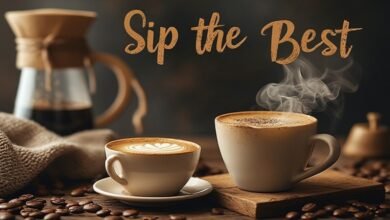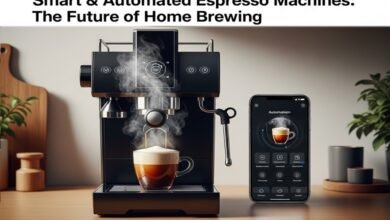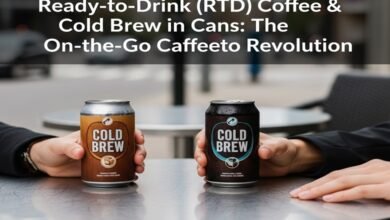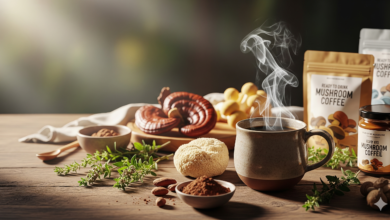Ready-to-Drink Coffee & Cold Brew Innovations: 2025’s Beverage Revolution
Coffee culture has always been dynamic, but in 2025, Ready-to-Drink (RTD) coffee and cold brew innovations are reshaping the way we consume our daily caffeine fix. No longer limited to traditional brewing at home or expensive café visits, consumers now reach for on-the-go bottles and cans that offer convenience, flavor, and even functional health benefits. Let’s explore how this trend is transforming the market and how new launches compare with classic favorites.
🚀 Why RTD Coffee Is Booming
The shift in lifestyle has fueled RTD coffee’s popularity:
- Busy urban consumers prefer grab-and-go options.
- Gen Z and Millennials are adventurous with flavors and packaging.
- Health-conscious buyers are looking for low-sugar, plant-based, and functional brews.
In fact, reports show that the global RTD coffee market is projected to grow at double digits annually through 2028, thanks to both café chains and indie brands innovating at lightning speed.
🧊 Cold Brew vs. Traditional RTD Coffee
✔️ Cold Brew
- Known for its smooth, less acidic flavor.
- Appeals to younger consumers who enjoy iced beverages year-round.
- Often infused with nitro for a creamy texture.
✔️ Traditional RTD Coffee
- Includes lattes, cappuccinos, and black coffee in bottles or cans.
- Familiar taste that appeals to mainstream coffee drinkers.
- Widely available at supermarkets and convenience stores.
👉 Comparison Insight: Cold brew dominates the premium space with artisanal vibes, while traditional RTD coffee remains the go-to for affordability and comfort.
🌟 Key Innovations in 2025
The competition in RTD coffee is fierce, and brands are pushing creativity:
- Functional Coffee: Added adaptogens, collagen, or probiotics for wellness-focused consumers.
- Plant-Based Creamers: Almond, oat, and coconut milk blends for a dairy-free lifestyle.
- Sugar Alternatives: Monk fruit, stevia, and natural sweeteners instead of refined sugar.
- Sustainable Packaging: Eco-friendly cans and recyclable bottles to appeal to green consumers.
- Flavor Fusions: Unexpected pairings like coffee + citrus, vanilla chai cold brew, and even sparkling coffee.
🌐 Big Players vs. Indie Brands
☕ Starbucks & Dunkin’
- Starbucks continues to lead with Nitro Cold Brew cans and oat-milk lattes.
- Dunkin’ keeps it classic with flavored RTD iced coffees like mocha and caramel.
🌱 Indie & Specialty Brands
- Brands like La Colombe, Califia Farms, and Chameleon Cold Brew focus on organic, clean-label, and artisanal brewing techniques.
- These cater to niche audiences who value both taste complexity and ingredient transparency.
👉 Comparison: Mainstream players dominate shelves with scale and affordability, while indie brands capture the premium, health-conscious crowd.
🎯 What Consumers Are Saying
Consumer reviews reveal a split:
- Flavor Adventurers love artisanal cold brews with bold flavors and low sugar.
- Convenience Seekers stick to familiar brands that are easy to grab anywhere.
- Wellness Enthusiasts are loyal to functional blends that give both energy and nutritional boosts.
This makes the RTD market one of the most diverse and inclusive beverage categories in 2025.
💡 How to Choose Your RTD Coffee
- For Smoothness: Pick a nitro cold brew for creamy texture without milk.
- For Energy + Health: Try functional blends with added protein or adaptogens.
- For Classic Taste: Go for bottled lattes or mochas from mainstream brands.
- For Sustainability: Support brands with eco-friendly packaging and fair-trade beans.
📈 The Trend Outlook
The future of RTD coffee lies in personalization and hybrid beverages. Imagine a bottle that’s not just coffee, but also your morning multivitamin, probiotic boost, or even a mood enhancer. With AI-driven product development and sustainable sourcing, 2025 is just the beginning of an exciting chapter.
✨ Final Thoughts: Coffee Without Limits
RTD coffee and cold brew innovations are more than just a beverage trend — they reflect the modern consumer’s desire for convenience, wellness, and creativity. Whether you’re sipping on a Starbucks nitro can, a Califia oat latte, or a citrus-infused artisan cold brew, the message is clear: coffee has evolved into a lifestyle choice, not just a drink.
In 2025, the real winner is the consumer, with endless options tailored to every mood, diet, and personality.



